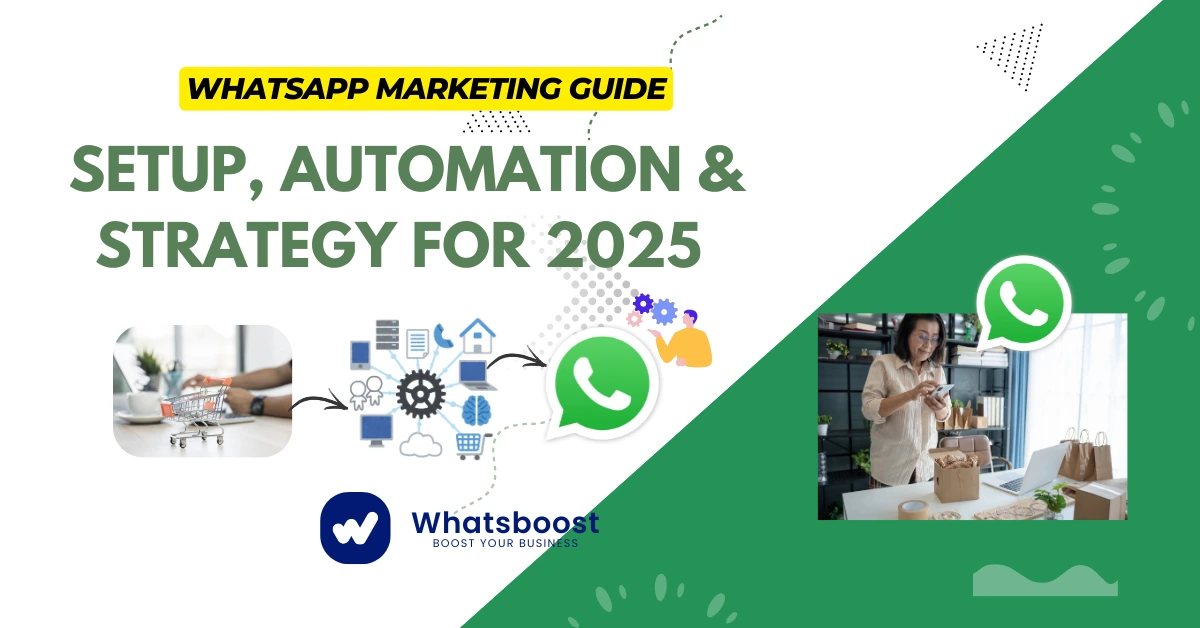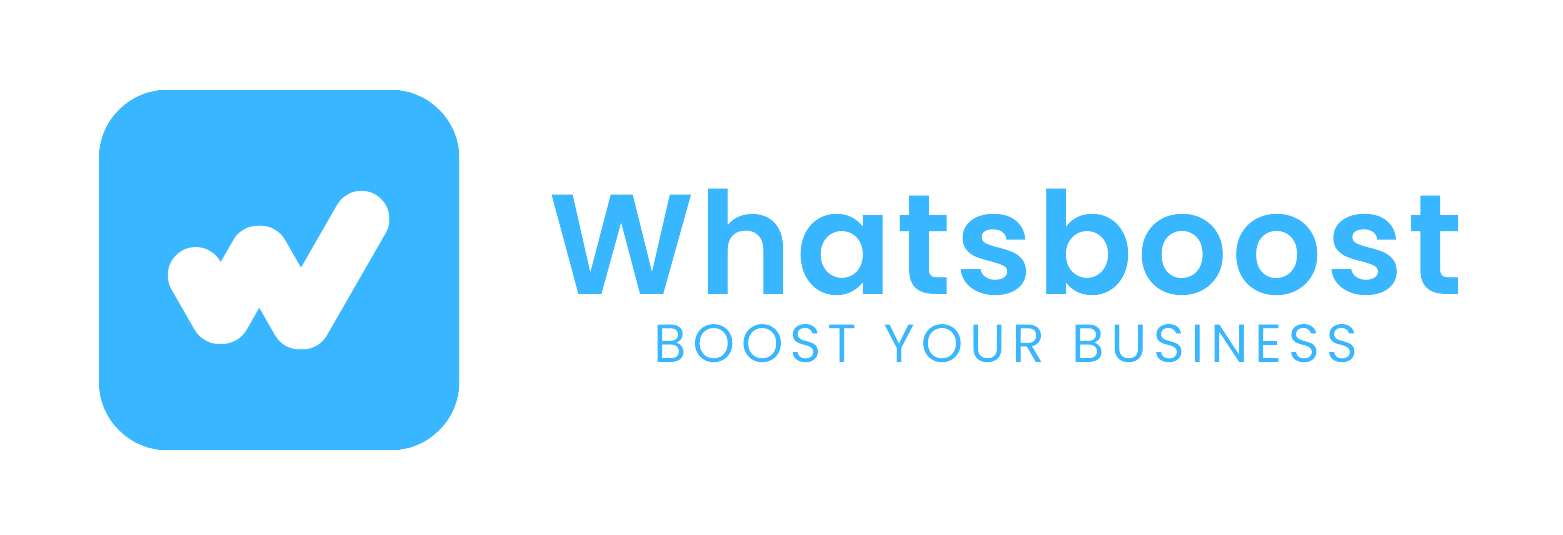
WhatsApp Marketing Guide: Setup, Automation & Strategy for 2025
Unlock a complete WhatsApp marketing roadmap for 2025—covering setup, automation, and strategy for e-commerce. Learn how Whatsboost helps scale WhatsApp campaigns, boost engagement and conversions.
1. Introduction
If your email campaigns go unopened, your SMS messages get ignored and your ads get scrolled past, it's time to meet your customers on their favourite platform: WhatsApp. With over 2.5 billion monthly users and open rates reaching 98%, WhatsApp offers a direct, trusted line of communication. By leveraging WhatsApp Business, automation workflows and strategic campaigns, e-commerce brands can build meaningful relationships, drive engagement and scale conversions.
In this guide, you’ll discover how to set up WhatsApp marketing properly, automate your workflows using Whatsboost, and implement a 2025 strategy tailored to e-commerce.
2. What is WhatsApp Marketing?
WhatsApp marketing uses the messaging app to promote your products or services, engage customers, and encourage action. Unlike email or SMS, WhatsApp allows for two-way conversations, rich media (images, video, product catalogs) and real-time interaction. People check WhatsApp dozens of times a day; according to aiSense, users open chats at least 23 times daily.
This means WhatsApp marketing is not just understandable—it’s conversational, immediate and highly effective for customer engagement.
3. WhatsApp Business App vs WhatsApp Business API: Which One to Choose?
WhatsApp Business App
-
Ideal for small stores, up to ~1,000 messages/month.
-
Free to use, but limited automation and team support.
WhatsApp Business API
-
Built for higher-volume operations (mid-sized and DTC stores).
-
Supports unlimited messaging (depending on tier), multi-agent support, automation and full e-commerce stack integration.
-
Usually accessed via a Business Solution Provider (BSP) or an automation platform like Whatsboost.
Comparison at a glance:
| Feature | Business App | Business API |
|---|---|---|
| Cost | Free | Pay-per-message / tiered |
| Multi-agent support | No | Yes |
| Automation capabilities | Basic | Advanced |
| Integration with e-commerce | Limited | Full stack (Shopify, CRM, etc) |
For serious e-commerce growth, the Business API (via a provider like Whatsboost) is the smart choice.
4. 5 Key Benefits of WhatsApp Marketing
-
High Open Rates: With ~98% open rates, your message stands a high chance of being seen.
-
Direct Customer Conversations: Real-time, two-way chats boost engagement and enable quicker conversions.
-
Cost-Effective: Compared to ads or SMS, WhatsApp can deliver 3-5× higher ROI when done right.
-
Seamless Shopping Experience: Send catalogs, track orders, send receipts—all within WhatsApp.
-
Automated Support & Engagement: Chatbots and workflows on Whatsboost can reduce support tickets by up to 40%.
5. How to Set Up WhatsApp Marketing in 6 Simple Steps
Step 1: Create & Verify Your WhatsApp Business Profile
Decide whether you’ll use the WhatsApp Business App (small scale) or the WhatsApp Business API. Get your business account verified (green tick) by providing business registration, address proof and logo. Verification helps improve trust and delivery.
Step 2: Choose the Right WhatsApp Marketing Software
Look for a platform that supports e-commerce integrations, automation workflows, broadcast & drip campaign capabilities. Whatsboost offers full features including: broadcast messaging, scheduled flows, Shopify integration, and analytics.
Step 3: Encourage Customer Sign-ups
You must have user consent (opt-in) before messaging. Use pop-ups, QR codes, landing pages, lead magnets and click-to-WhatsApp ads to invite subscribers. Be transparent about frequency and message type.
Step 4: Segment Audiences & Personalize Messages
E-commerce campaigns hit harder when tailored. Segment your list by purchase history, location, interest, engagement level, etc. Personalization (e.g., “Hi {{first_name}}, here’s a special offer for you!”) can raise conversion by 10–15%.
Step 5: Set Up WhatsApp Automation
Create automated flows such as:
-
Welcome messages for new subscribers
-
Abandoned-cart reminders (recover up to ~20%)
-
Order confirmation & shipping updates
-
Post-purchase follow-ups
With Whatsboost you can build these with no code, schedule them, and tailor them for e-commerce.
Step 6: Track Performance & Optimize
Monitor key metrics: delivery rate, open rate, click-through rate (CTR), conversion rate. A/B test message content, send times and segments. Refine your WhatsApp marketing campaigns based on data.
6. Types of WhatsApp Campaigns for E-commerce
1. Broadcast Messages
One-time messages sent to many recipients—ideal for product launches, flash sales, restock alerts. Each recipient receives it as a one-on-one chat.
2. Automated Flows (Drip Campaigns)
Sequence of messages triggered over time based on user actions—perfect for lead nurturing, onboarding, cart recovery.
3. Click-to-WhatsApp Ads
Use Facebook/Instagram ads with “Message Us” buttons to send users into WhatsApp chats directly—great for capturing leads and retargeting.
4. WhatsApp Status Marketing
Use WhatsApp’s Status feature to post behind-the-scenes, teasers, flash deals or testimonials. It’s less intrusive and builds brand awareness.
7. Best Automation Flows to Deploy
Abandoned Cart Recovery
Sequence:
-
1 hr post-abandonment → message with product image & link
-
24 hrs later → reminder + urgency
-
72 hrs later → final offer or discount
Order Confirmation & Delivery Updates
Messages:
-
Order receipt
-
Processing notification
-
Shipping update with tracking
-
Delivery confirmation & feedback request
Loyalty & Re-engagement Loop
Re-engage customers who haven’t purchased recently with exclusive offers or access to VIP collections.
Customer Support & Upsell Flow
Use WhatsApp to handle support queries automatically, then flag complex issues to agents. Follow up with product recommendations.
8. Campaign Strategy by Funnel Stage
-
Acquisition: Use QR codes, pop-ups, click-to-WhatsApp ads to build your list.
-
Nurture: Use drip campaigns, personalized messages and educational content to build trust.
-
Conversion: Use urgency, personalization, tailored offers and clear CTAs.
-
Retention: Use loyalty programs, exclusive deals, feedback loops and VIP access via WhatsApp.
9. Rules & Best Practices for WhatsApp Marketing
Meta Messaging Policy & Template Approval
Use approved templates for promotional messages. Violation can lead to account restrictions.
GDPR & Opt-In/Opt-Out Compliance
Always collect explicit consent, provide opt-out options and respect user preferences.
Segmentation & Send Frequency
Avoid spamming: limit promotional messages to ~2–4/month, segment effectively, respect user’s timezone and engagement patterns.
10. Why Choose Whatsboost for WhatsApp Campaigns
Whatsboost is a full-fledged WhatsApp automation platform built for e-commerce and marketing teams. It provides:
-
Broadcast & drip campaign tools
-
Shopify/WooCommerce integration
-
No-code workflow builder
-
Advanced segmentation & personalization
-
Real-time analytics and optimization
-
Compliance features and official API access
Explore Whatsboost’s features here: Whatsboost – Features
11. Frequently Asked Questions
About WhatsApp Marketing for E-commerce
Q1. What is the typical open rate for WhatsApp campaigns?
Most brands report open rates of ~98% on WhatsApp—significantly higher than email or SMS.
Q2. Can WhatsApp really replace my email marketing?
Not entirely—but it can greatly complement it. WhatsApp works best for high-engagement, relational marketing and transactional messages.
Q3. How soon can I see results from WhatsApp automation?
You can observe improvement in engagement and conversion within days of setting up flows; meaningful ROI may follow within weeks as you optimize.
About Whatsboost as a Business
Q4. What is Whatsboost?
Whatsboost is an automation platform for WhatsApp marketing, offering broadcast, drip, workflow automation and integration with e-commerce systems.
Q5. Is Whatsboost compliant with WhatsApp’s policies?
Yes. Whatsboost uses the official WhatsApp Business API (or compliant workflow) and supports template approvals, opt-out management, and rate limiting.
Q6. Can small e-commerce stores use Whatsboost?
Absolutely. Whether you’re just getting begun or scaling fast, Whatsboost’s tiered plans and automation features scale with you.
12. Conclusion
WhatsApp marketing is no longer a “nice to have” — it’s a growth driver for e-commerce brands in 2025. By combining WhatsApp Business, automation workflows, and strategic campaigns, you can build relationships, increase conversions and scale communication.
With Whatsboost, you have the tools to create personalized, timely campaigns and integrate WhatsApp into your marketing tech stack.
🚀 Ready to start? Visit Whatsboost – Start Now and launch your WhatsApp marketing strategy today.
